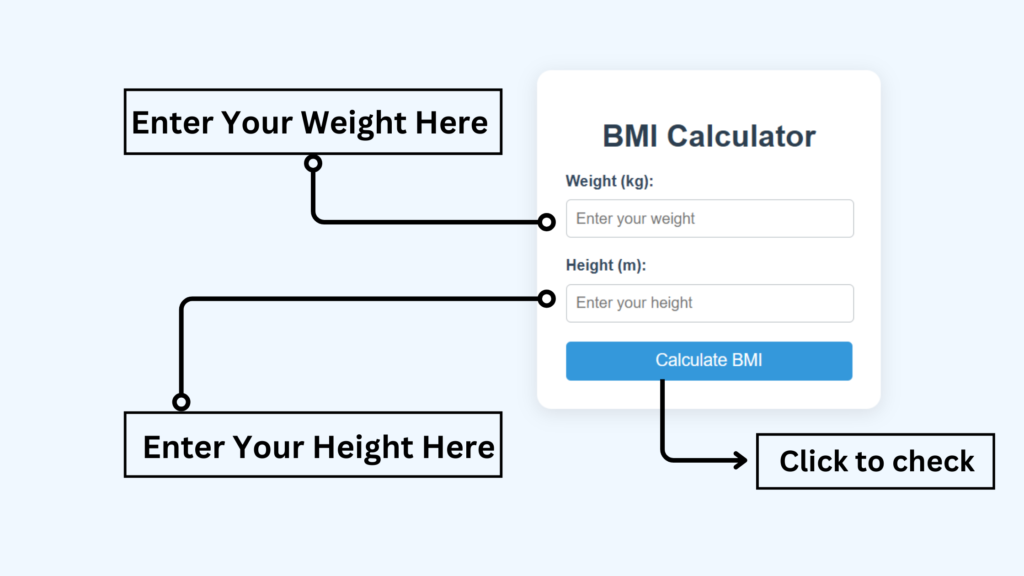In an age where health awareness is crucial, tracking your Body Mass Index (BMI) has become one of the simplest and most effective ways to assess overall health and fitness. BMI is an easy-to-use metric that helps determine whether you’re underweight, within a healthy weight range, overweight, or obese. By offering a clear picture of your weight relative to your height, it serves as a valuable tool for understanding your physical well-being. But how do we calculate BMI, and why is it so widely relied upon?
BMI is a simple and effective tool that helps assess whether you’re underweight, within a healthy weight range, overweight, or obese. But what exactly is BMI, and how to calculate BMI to determine where you stand?
This guide will explain how to compute BMI, how to figure BMI manually, and why it matters for your overall well-being. If you’ve ever wondered how is BMI calculated, read on for an easy breakdown and practical tips to help you measure your BMI effortlessly.
Calculate Your BMI Free With BMI Calculator Online
BMI Calculator - Suthar Solutions
In this blog post, we’ll demystify the BMI formula, explore its significance, and discuss how it plays a key role in evaluating your health status. Whether you’re just curious or taking steps toward a healthier lifestyle, understanding BMI is the perfect starting point.
Let’s dive in!
Table of Contents
What is BMI?
BMI, or Body Mass Index, is a numerical value derived from your weight and height. It helps indicate whether an individual falls into a specific weight category that could impact their health, such as underweight, normal, overweight, or obese.
Formula:
BMI = Weight (kg) / Height (m²)
For those using pounds and inches, the formula is:
BMI = (Weight (lbs) / Height (in²)) x 703
Why is BMI Important?
BMI is widely used because it provides a quick snapshot of your body weight status. Although it’s not a comprehensive measure of health, it can help identify risks for conditions like heart disease, diabetes, and high blood pressure. Here’s why BMI matters:
- Disease Prevention: High BMI values have been linked to increased risk for chronic diseases. Monitoring your BMI can help you stay within a healthy range and reduce health risks.
- Fitness Goals: BMI can be an easy metric to help set and track weight-related goals for fitness or health.
- Self-Awareness: Regular BMI checks provide insight into your body’s changes over time, encouraging a proactive approach to well-being.
How Do We Calculate BMI
Calculating your BMI is simple, and there are multiple methods you can use. Let’s dive into each one.
1. How to Calculate BMI Manually
If you’re curious about how to measure BMI manually, it’s quite simple. Follow these steps:
Start with the Formula
The standard formula for BMI is: BMI= Weight (kg) / Height (m²)
Alternatively, for pounds and inches: BMI= Weight (lbs) x 703 / Height (in²)
- Metric Formula:
- Step 1: Measure your weight in kilograms.
- Step 2: Measure your height in meters and square it (multiply it by itself).
- Step 3: Divide your weight by your squared height.
Example: If you weigh 70 kg and are 1.75 meters tall, the calculation would be 70 ÷ (1.75 x 1.75) = 22.9.
- Imperial Formula:
- Step 1: Measure your weight in pounds.
- Step 2: Measure your height in inches and square it.
- Step 3: Multiply your weight by 703, then divide by your squared height.
Example: If you weigh 154 lbs and are 65 inches tall, the calculation would be (154 x 703) ÷ (65 x 65) = 25.6.
FAQs about Manual BMI Calculation:
- How can I calculate my BMI at home? You can use the formula with your weight and height.
- What tools do I need to how to compute BMI manually? Just a calculator, your height, and your weight.
2. Using an Online BMI Calculator
Don’t want to calculate manually? No problem! Many online tools make it easy to figure out how to compute for BMI. Simply input your weight and height, and the calculator does the rest. A BMI calculator provides an instant, accurate result, perfect for tracking your health metrics regularly.

Step-by-Step Guide to How to Calculate BMI using BMI Calculator
Our tool is designed for easy use:
- Input Your Height and Weight
Enter your height (in inches or centimeters) and weight (in pounds or kilograms) into the calculator fields. - Calculate Your BMI
Click the “Calculate” button to instantly see your BMI score. - View Your Results
The result will show your BMI along with an interpretation—whether you are underweight, normal, overweight, or obese. - Interpret the Findings
Use the provided interpretation to understand what your BMI score suggests about your body weight relative to height.
Also Read: #1 Free QR Code Generator: Create and Customize Your QR Codes
FAQs about Online BMI Calculators:
- Are online BMI calculators accurate? Yes, online calculators use the same formula, offering quick and reliable results.
- Can I calculate BMI on my smartphone? Absolutely, most BMI calculators are mobile-friendly and easy to use on any device.
3. BMI Calculation for Children
BMI interpretation differs for children as their BMI is evaluated according to age and gender. Pediatric BMI is calculated similarly but compared to a growth chart to determine the percentile range:
- Step 1: Calculate the BMI using the standard formula for weight and height.
- Step 2: Check the BMI against a percentile chart (based on age and gender).
FAQs about BMI for Children:
- Can I calculate BMI for my child? Yes, but it’s best used as a screening tool with percentile charts for accuracy.
- Is BMI accurate for children? It provides a useful indicator but is best combined with other health assessments.
4. Tips for Tracking BMI Over Time
Monitoring your BMI over time can offer valuable insights into your health journey. Here are some tips:
- Set Regular Checks: Check your BMI every few months or after any major changes in diet or exercise.
- Track Your Progress: Record your BMI in a journal or app to see trends.
- Consider Your Lifestyle: BMI is just one part of health. Keep track of other metrics such as body measurements, activity levels, and dietary choices.
Understanding BMI Categories
Once you’ve learned how to compute a BMI, the next step is interpreting the results. Here’s what the numbers typically mean:
- Underweight: BMI less than 18.5
- Healthy Weight: BMI between 18.5 and 24.9
- Overweight: BMI between 25 and 29.9
- Obese: BMI 30 and above
These categories serve as a general guideline. For a more personalized assessment, consult a healthcare professional.
Why BMI Isn’t the Whole Picture
Understanding how to calculate BMI is undoubtedly helpful, but it’s important to recognize its limitations. While BMI serves as a quick and easy way to assess weight relative to height, it doesn’t provide a full picture of your health. Here’s why:
1. It Doesn’t Account for Body Composition
BMI considers only your weight and height, ignoring how much of your body is composed of fat, muscle, or bone. This can lead to misleading interpretations, especially in these cases:
- Athletes and Bodybuilders: Individuals with significant muscle mass may have a high BMI, categorizing them as overweight or obese, even though their body fat percentage is low.
- Older Adults: As people age, they may lose muscle mass and bone density, potentially lowering their BMI even if their body fat percentage increases.
2. Bone Density and Frame Size Are Overlooked
BMI calculations do not factor in bone density or frame size, which can significantly affect body weight. For example:
- People with denser bones may weigh more, leading to a higher BMI that doesn’t accurately reflect their health.
- Individuals with smaller frames might appear to have a healthy BMI despite having higher body fat percentages.
3. It Doesn’t Consider Fat Distribution
Where fat is stored in your body can be a more critical indicator of health than the total amount of fat. BMI doesn’t distinguish between subcutaneous fat (stored under the skin) and visceral fat (stored around vital organs).
- Visceral Fat: High levels of visceral fat are linked to increased risks of cardiovascular diseases, diabetes, and metabolic disorders.
- Two individuals with the same BMI might have vastly different health risks based on their fat distribution.
4. It Doesn’t Reflect Gender or Age Differences
BMI uses the same formula for everyone, regardless of age or gender. However, men and women naturally have different body fat percentages, and these differences should ideally be taken into account.
- Women typically have higher body fat percentages than men, even at the same BMI.
- Children and adolescents require age- and gender-specific BMI percentiles to accurately assess their growth and health.
5. It Ignores Lifestyle and Other Health Factors
BMI doesn’t provide insights into an individual’s lifestyle, diet, physical activity, or metabolic health. A person with a healthy BMI might still have poor dietary habits, low activity levels, or underlying health conditions. Conversely, someone with a higher BMI might have excellent cardiovascular fitness and a balanced diet.
6. It Doesn’t Consider Ethnic Variations
BMI thresholds may not be equally applicable across all ethnic groups. Research has shown that individuals of certain ethnic backgrounds might have different health risks at the same BMI level. For example:
- Asian populations may have higher risks of diabetes and cardiovascular diseases at lower BMI thresholds.
- Black populations often have higher bone density and muscle mass, which can result in higher BMIs without increased health risks.
7. Mental and Emotional Health Are Not Reflected
BMI calculations focus solely on physical measurements, neglecting the impact of mental and emotional health. Weight stigma or an overemphasis on BMI can lead to stress, anxiety, or unhealthy behaviors such as disordered eating. Health is multidimensional and encompasses mental and emotional well-being, which BMI cannot measure.
What Are the Alternatives or Complements to BMI?
To get a more accurate assessment of your health, consider combining BMI with other metrics, such as:
- Waist-to-Hip Ratio (WHR): Measures fat distribution around the waist compared to the hips, providing insights into cardiovascular risk.
- Body Fat Percentage: Determines the proportion of fat in your body using tools like calipers, bioelectrical impedance, or DEXA scans.
- Waist Circumference: A standalone measurement of abdominal fat, which is a key indicator of metabolic health.
- Resting Heart Rate and Blood Pressure: Provide insights into cardiovascular health.
- Lipid and Glucose Levels: Blood tests that assess cholesterol, triglycerides, and blood sugar for a more comprehensive health picture.
Conclusion
While knowing how to calculate BMI is a good starting point, it’s essential to view it as just one piece of the puzzle. Health is complex and influenced by numerous factors beyond weight and height. Combining BMI with other health metrics and seeking professional advice can help you better understand your overall well-being and create a more personalized plan for health and fitness.
Remember, health is more than just numbers—it’s about living a balanced, fulfilling life.
FAQs about Calculating BMI
- What is BMI?
BMI, or Body Mass Index, is a simple metric derived from weight and height to help determine if someone falls within a healthy weight range. - How can I calculate my BMI quickly?
Use an online BMI calculator, or use the formula with your weight and height for a quick calculation. - How do I calculate BMI in pounds and inches?
Multiply your weight by 703, then divide by the square of your height in inches. - Can BMI calculation be used for children?
Yes, but it requires age- and gender-specific percentiles, which are available in pediatric BMI charts. - How often should I check my BMI?
Checking your BMI every few months or whenever you make significant lifestyle changes is beneficial. - Is BMI accurate for muscular people?
BMI can overestimate fat in muscular individuals, as it doesn’t account for muscle mass. - Can I calculate my BMI on my phone?
Yes, online calculators and health apps make it easy to calculate BMI on any device. - What’s a healthy BMI range?
A BMI between 18.5 and 24.9 is generally considered healthy for adults. - Does BMI change as I age?
Your BMI can change over time based on weight fluctuations and height changes, especially with age. - What should I do if my BMI is high?
Consider discussing your BMI with a healthcare provider to develop a healthy lifestyle plan.



